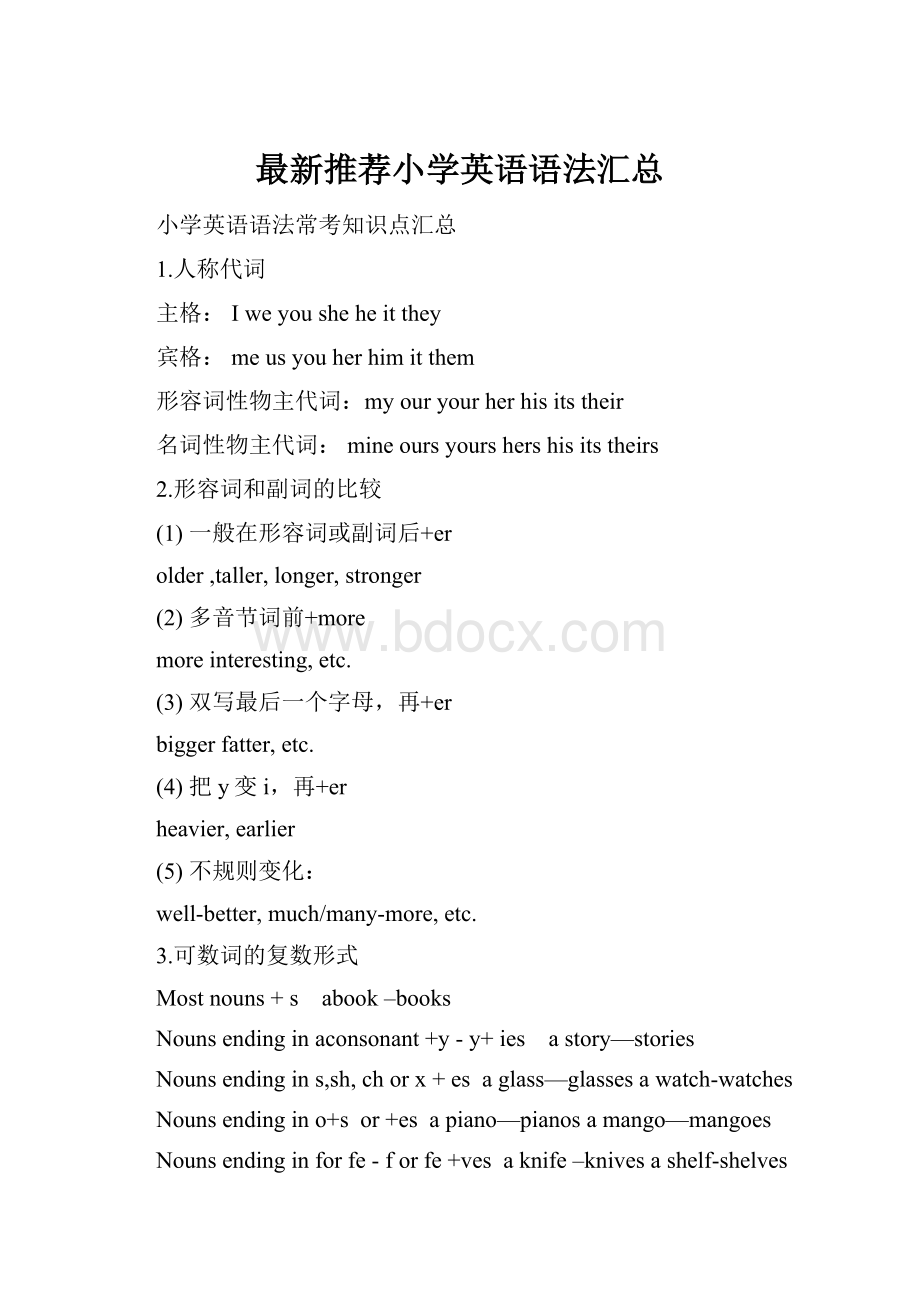最新推荐小学英语语法汇总.docx
《最新推荐小学英语语法汇总.docx》由会员分享,可在线阅读,更多相关《最新推荐小学英语语法汇总.docx(7页珍藏版)》请在冰豆网上搜索。

最新推荐小学英语语法汇总
小学英语语法常考知识点汇总
1.人称代词
主格:
Iweyousheheitthey
宾格:
meusyouherhimitthem
形容词性物主代词:
myouryourherhisitstheir
名词性物主代词:
mineoursyourshershisitstheirs
2.形容词和副词的比较
(1)一般在形容词或副词后+er
older,taller,longer,stronger
(2)多音节词前+more
moreinteresting,etc.
(3)双写最后一个字母,再+er
biggerfatter,etc.
(4)把y变i,再+er
heavier,earlier
(5)不规则变化:
well-better,much/many-more,etc.
3.可数词的复数形式
Mostnouns+s abook–books
Nounsendinginaconsonant+y-y+ies astory—stories
Nounsendingins,sh,chorx+es aglass—glassesawatch-watches
Nounsendingino+s or+es apiano—pianosamango—mangoes
Nounsendinginforfe-forfe+ves aknife–knivesashelf-shelves
4.不可数名词(单复数不变)
bread,rice,water,juice等。
5.缩略形式
I’m=Ia, you’re=youare,she’s=sheis,he’s=heis
it’s=itis,who’s=whois,can’t=cannot,isn’t=isnot等。
6.a/an
abook, apeach
anegg,anhour
7.Preposition
on,in,infrontof,between,nextto,near,beside,at,behind.
表示时间:
atsixo’clock,atChristmas,atbreakfast
onMonday,on15thJuly,OnNationalDay
intheevening,inDecember,inwinter
8.基数词和序数词
one–first,two-second,twenty-twentieth
9.some/any
Ihavesometoysinmybedroom.
Doyouhaveanybrothersorsisters?
10.be动词
(1)Basicform:
am/are/is
(2)肯定和否定句Iam(not)fromLondon.
Myeyesare(not)small.
Myhairis(not)long.
(3)一般疑问句:
AmIaChniese?
Yes,youare. No,youaren’t.
AretheyAmerican?
Yes,theyare. No,theyaren’t.
Isthecatfat?
Yes,itis. No,itisn’t.
11.there be结构
肯定句:
Thereisa…
Thereare…
一般疑问句:
Isthere…?
Yes,thereis./No,thereisn’t.
Arethere…?
Yes,thereare./No,therearen’t.
否定句:
Thereisn’t….
Therearen’t….
12.祈使句
Sitdownplease
Don’tsitdown,please.
13.现在进行时
通常用“now”.
形式:
be+verb+ing
eg:
Iam(not)doingmyhomework.
You/We/Theyare(not)reading.
He/She/Itis(not)eating.
动词—ing的形式
Mostverbs+ingwalk—walking
Verbsendingine-e+ingcome—coming
Shortverbsendinginavowel+aconsonantrun–runningswim—swimming
14.一般现在时
通常用“usually,often,everyday,sometimes”。
肯定句:
Igotoschoolonfooteveryday.
Shegoestoschoolonfooteveryday.
一般疑问句:
Doyoujumphigh?
Yes,Ido./No,Idon’t.
Doeshejumphigh?
Yes,hedoes./No,hedoesn’t.
否定句:
Wedon’tgotoschoolonSundays.
Mymotherdoesn’tlikewatchingTVintheevening.
15.情态动词
can,must,should后面直接用动词原形。
eg:
1.I/He/She/Theycansing.
2.Youshouldkeepquietinthelibrary.
16.一般过去时态
(a)be动词的过去式:
I/He/she/itwas(not)….You/we/theywere….
一般疑问句was,were放在句首。
(b)动词过去式:
肯定句:
Iwatchedcartoons.
Shevisitedthezoo.
一般疑问句:
Didyoureadbooklastnight?
Yes,Idid.No,Ididn’t.
Didshecleanthedeskjustnow?
Yes,shedid.No,shedidn’t.
否定句:
Theydidn’tgothethepartyesterday.
Hedidn’tmakemodelshipslastweek.
(3)动词过去式的变化:
规则动词的变化:
Mostverbs+ed eg.planted,watered,climbed。
Verbsendingine+d egliked。
Verbsendinginaconsonant+y--y+ied eg:
study—studied
Shortverbsendinginavowel+aconsonant eg:
stop--stopped
不规则动词的变化:
is/am—was,are—were,do—did,have/has—had,make—made,fly-flew,
eat—ate,take—took,run—ran,sing—sang,drink—drank等等
17.Wh-"questions"
Whatareyoudoing?
Whatcolourisit?
Whattimeisit?
/What’sthetime?
Whichisyourwatch,theyellowoneorthewhiteone?
Who’sthemanwithabignose?
Whosebagisit?
Whenisyourbirthday?
Whereismyballpen?
Whydoyoulikesummer?
Howmanybooksarethereintheschoolbag?
Howoldistheyoungman?
Howmuchisthetoybear?
Howdoyougotoschooleveryday?
1、一般现在时
A、表示不受时限的客观存在如:
Heisaboy. Sheisastudent.
Mymotherisanurse. Thisisadog. Ihaveabook.
B、表示现在的习惯动作,即指现在经常发生的动作,一般现在时常用来表示现在时间里某种动作的经常性和习惯性。
它常与表示程度或频度的词连用,
如:
often(经常),usually(通常,一般),sometimes(有时),
always(总是,一直),never(从不)
如:
Ioftengotoschoolonfoot.
Myfatherworksinaschool.
MikewatchesTVeveryday.
Iusuallyplaycomputergamesontheweekend.
C、表示现时的状态和现在瞬间动作.如:
Howareyou?
Youlookhappy. What’sthematterwithyou?
Ihaveaheadache.Whatdoyouhaveforlunch?
Ihavesomechicken.
☆注意☆ 英语动词的现在时与原形同形。
但当主语是第三人称单数时,须在词尾加s或-es。
例如:
Ihaveafishfordinner. Hermotherworksinahospital. Amyoftengoestoschoolbybike. Mr.LiuteachesusEnglish. 加-es的动词必须是以“sh,ch,o”等字母结尾的。
如:
watches,teaches,goes,washes
2、一般将来时
表示在将来会发生的事或动作。
它常与表示将来的时间连用,如:
tomorrow,nextweek,nextyear,thismorning,thisafternoon,thisevening等
☆注意☆ 一般将来时小学阶段主要学了两种结构:
①begoingto+动词的原形/地点
②will+动词的原形
例句:
I’mgoingtogoshoppingthisafternoon. SheisgoingtoHongKongnextweek.Youwillseemanybirdsinthesky.
3、现在进行时
表示说话时正在进行的动作或现阶段一直在进行的动作。
☆注意☆它的构成是:
be的现在时形式(am,is,are)加动词的ing形式。
如:
Whatareyoudoing?
I’mwritingaletter. Whataretheydoing?
They’reswimming.Isheplayingchess?
Yes,heis.Look,AmyisreadinganEnglishbook.
☆ 注意☆动词的ing形式的构成规则:
☆ ① 一般的直接在后面加上ing,如doing,going,working,singing,eating
②以e结尾的动词,要先去e再加ing ,如having,writing
③双写最后一个字母的(此类动词极少)有:
running,swimming,sitting,getting
4、一般过去时
主要用来表示在特定过去时间中一次完成的动作或一度存在的状态,也可表示过去的习惯动作。
它与现在时间不发生关系,它表示的动作或状态都已成为过去,现已不复存在。
它经常与表示过去的时间连用。
如:
Iwenttoaparkyesterday. Ireadabooklastnight.IwatchedTVyesterdayevening.Iwentonabigtriplastweekend. IfailedmyChinesetest.
☆注意☆ 一般过去时主要体现在动词的形式要用过去式,动词的过去式的构成规则有:
A、规则动词① 一般直接在动词的后面加ed ;如 worked,learned,cleaned,visited② 以e结尾的动词直接加d ;如 lived,danced,used
③ 以辅音字母加y结尾的动词要改y为i再加ed (此类动词较少)如 study–studiedcarry–carriedworry–worried(play、stay除外)④双写最后一个字母(此类动词较少)如 stopped
B、不规则动词(此类词并无规则,须熟记)小学阶段要记住以下动词的原形和过去式:
sing–sang, eat–ate, see–saw, have–had, do–did,
go–went, take–took, get–got, read–read, am/is–was, are–were, say–said, tell–told, come–came, drink–drank